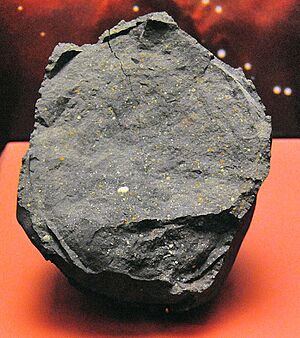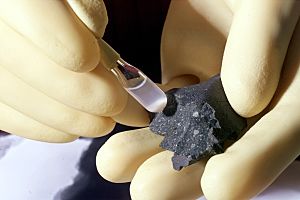Murchison meteorite facts for kids
The Murchison meteorite is a famous space rock that fell to Earth. It landed near Murchison, Victoria, Australia. This meteorite is very special because it contains many organic compounds. These are the building blocks of life. Scientists study it to learn about the early Solar System and how life might have begun.
On September 28, 1969, around 10:58 am, a bright fireball was seen in the sky. It broke into three pieces before vanishing, leaving a smoke trail. About 30 seconds later, a loud tremor was heard. People found pieces of the meteorite spread over an area larger than 13 square kilometers. Some pieces weighed up to 7 kilograms. One piece, weighing 680 grams, even crashed through a roof and landed in hay! In total, more than 100 kilograms of the meteorite were collected.
What the Murchison Meteorite is Made Of
Scientists wanted to know if the organic compounds found in the Murchison meteorite truly came from space. They also wondered how many different types of compounds were present. The answer is yes, they came from space, and there are very, very many different kinds!
This type of meteorite is called a carbonaceous chondrite. It is rich in carbon and is considered one of the most basic types of meteorites. The Murchison meteorite contains over 15 different amino acids. Amino acids are important because they are the building blocks of proteins, which all living things need.
Scientists have even made amino acids in labs by using electricity on a mix of gases like methane, nitrogen, and water. This shows how these compounds might form naturally in space.
Most of the amino acids in the meteorite were "racemic." This means they had an almost equal mix of "left-handed" and "right-handed" forms. On Earth, living things mostly use "left-handed" amino acids. Finding an equal mix suggests the amino acids did not come from contamination on Earth. Also, common Earth contaminants like serine and threonine were not found in the samples.
In 1997, research showed that amino acids from Murchison had more of a special type of nitrogen, called 15N. This was different from nitrogen found on Earth. This discovery strongly confirmed that these compounds came from space. Scientists also found sugar-like compounds in the meteorite.
A study in 2010 used advanced tools to look closely at a small piece of the meteorite. They found 14,000 different molecular compounds, including 70 types of amino acids. The team believes there could be millions of different organic compounds in the Murchison meteorite! This shows how incredibly rich this space rock is in the chemicals needed for life.
Building Blocks of DNA
Scientists also found purine and pyrimidine compounds in the Murchison meteorite. These are very important because they are the basic parts of DNA and RNA, which carry genetic information in all living things.
By studying the carbon in these compounds, scientists confirmed they came from space. These findings suggest that many organic compounds, which are key to life on Earth, were already present in the early Solar System. This means meteorites like Murchison might have delivered these important ingredients to early Earth, playing a big role in how life began.
See also
 In Spanish: Meteorito Murchison para niños
In Spanish: Meteorito Murchison para niños



